Abstract
BACKGROUND: Understanding the changes in energy expenditure and body composition is essential for the optimal management of the critically injured, yet these changes have not been quantified within the current context of trauma care. METHODS: Ten critically injured patients (median Injury Severity Score = 35) had measurements of energy expenditure and body composition as soon as they were hemodynamically stable and then every 5 days for 21 days. RESULTS: Resting energy expenditure rose to 55% above predicted and remained elevated throughout the study period. Total energy expenditure was 1.32 X resting energy expenditure. Body fat was oxidized when energy intake was insufficient (r=-0.830, p<0.02). Body water changes closely paralleled body weight changes and were largely accounted for by changes in extracellular water. Over the 21-day study period, there was a loss of 1.62 kg (16%) of total body protein (p<0.0002), of which 1.09 kg (67%) came from skeletal muscle. Intracellular potassium was low (133 +/- 3 mmol/L, p<0.02) but did not deteriorate further after hemodynamic stability had been reached. CONCLUSIONS: These results show that the period of hypermetabolism lasts longer and the protein loss is greater in critically injured patients than previously thought. Most, but not all, the protein is lost from muscle. Fat loss can be prevented and cell composition preserved once hemodynamic stability is achieved.
Full text
PDF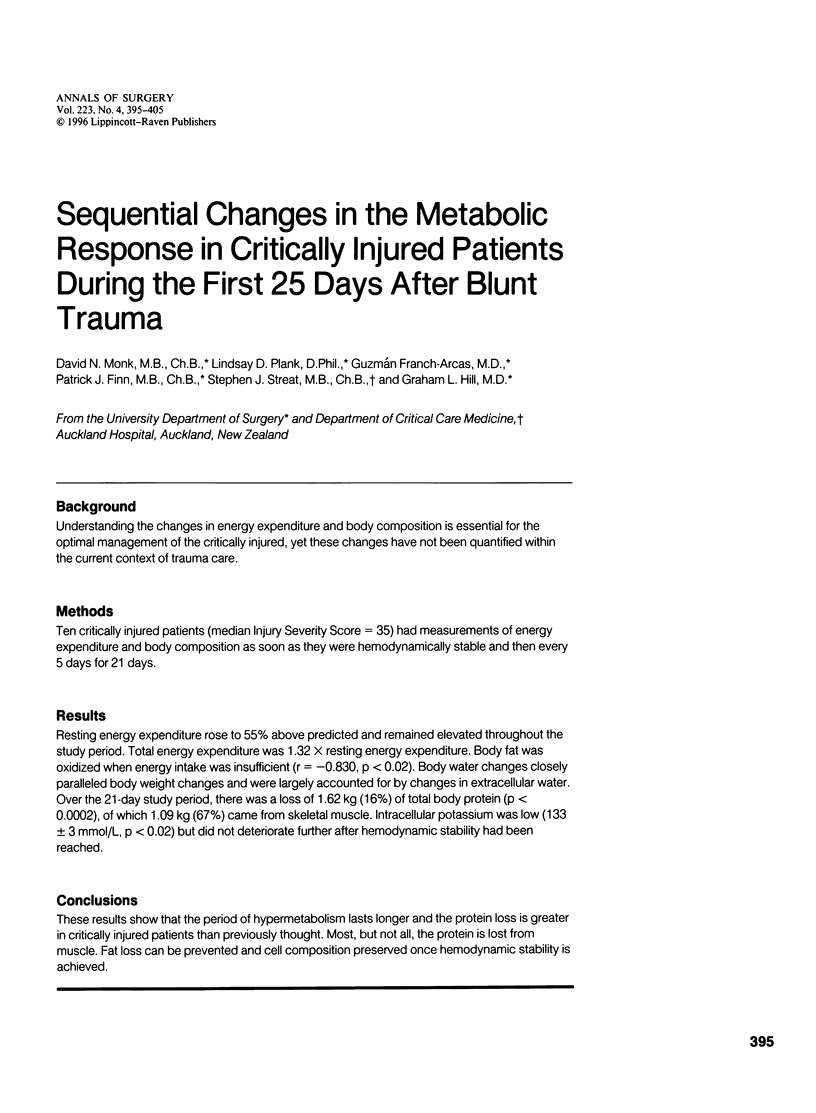
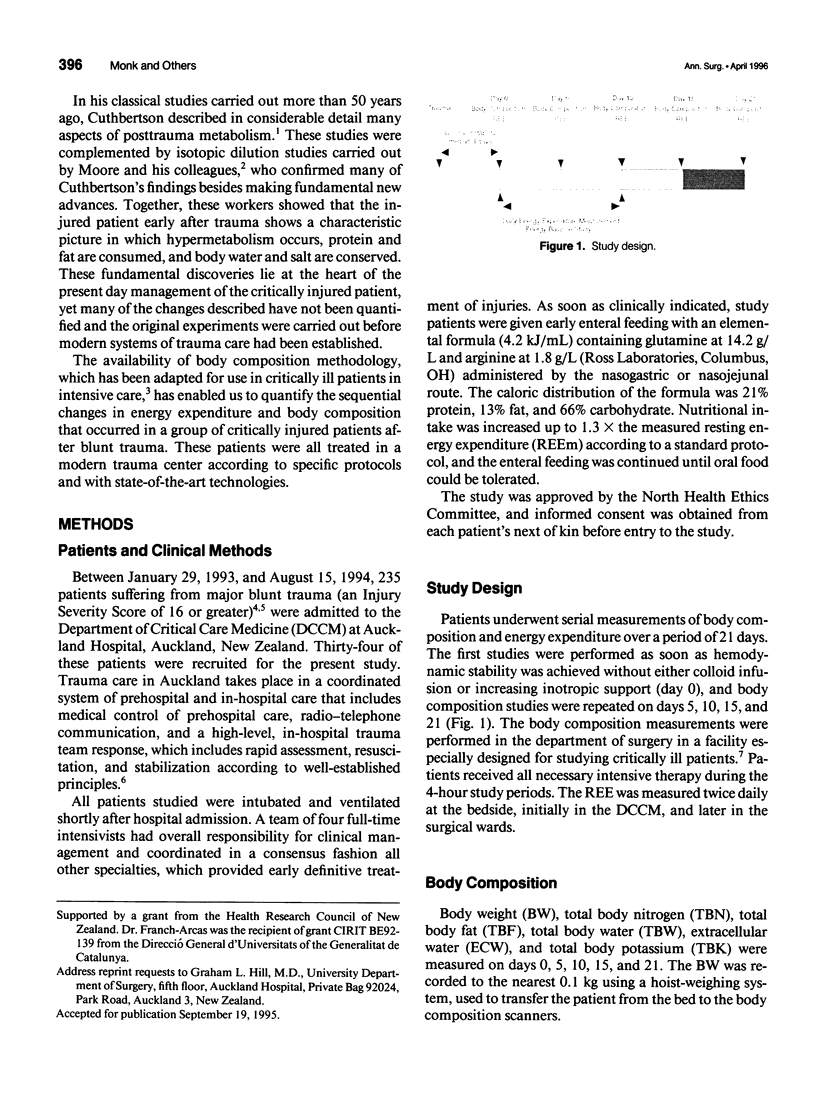
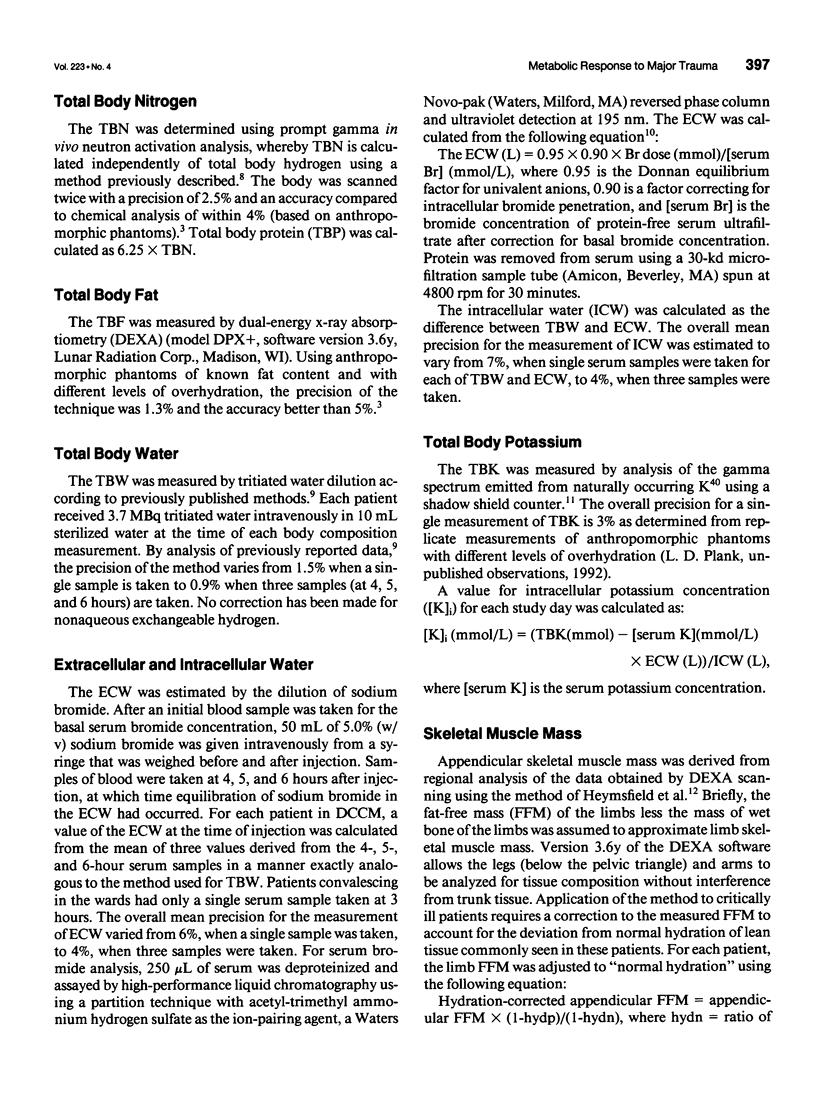
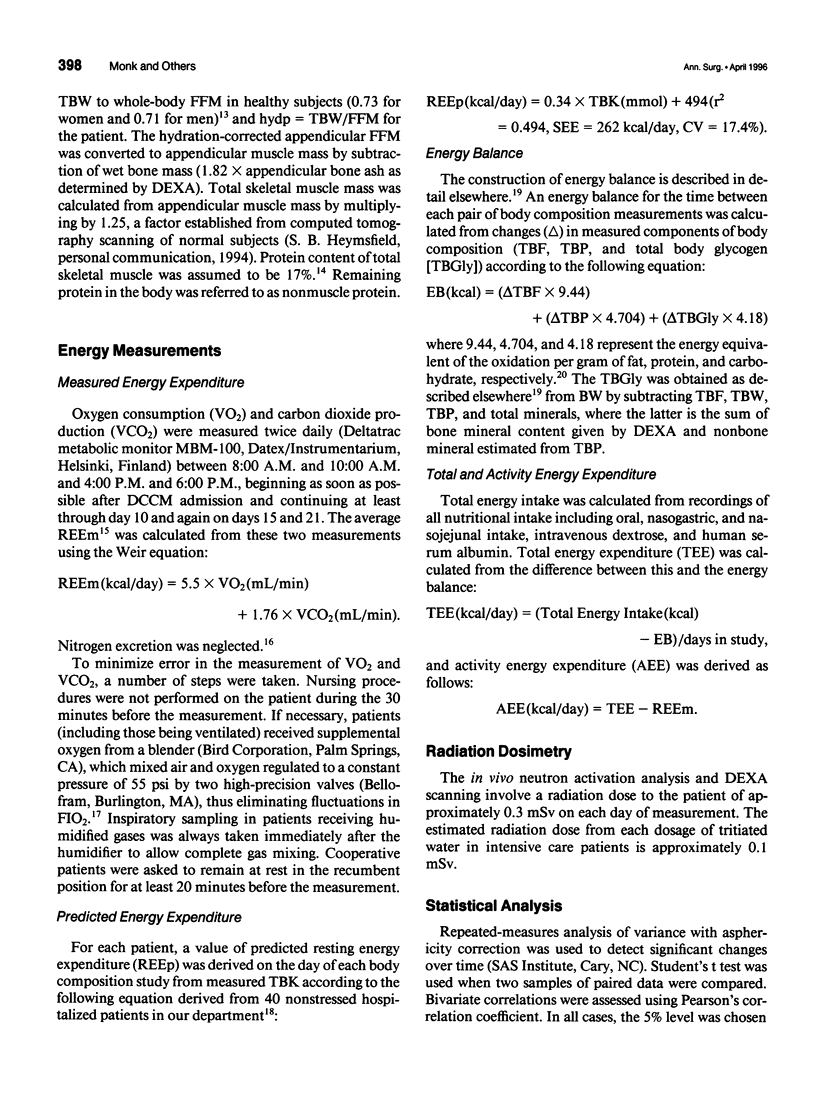
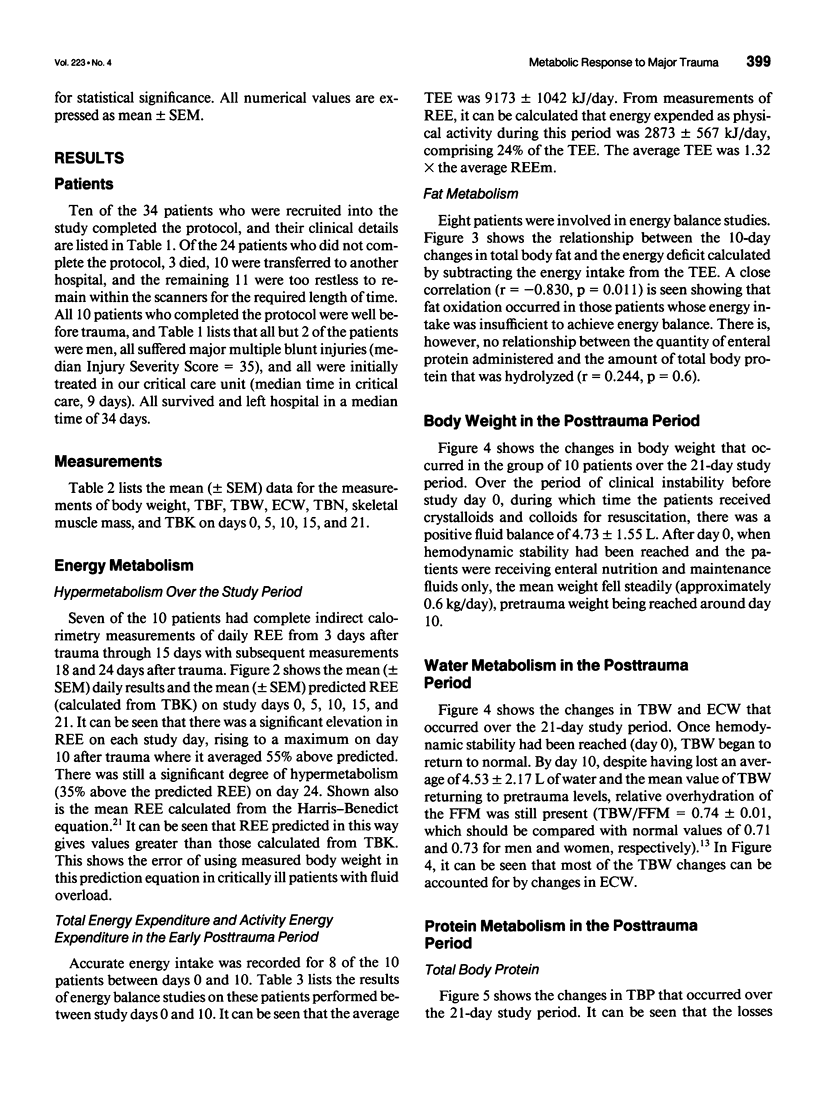
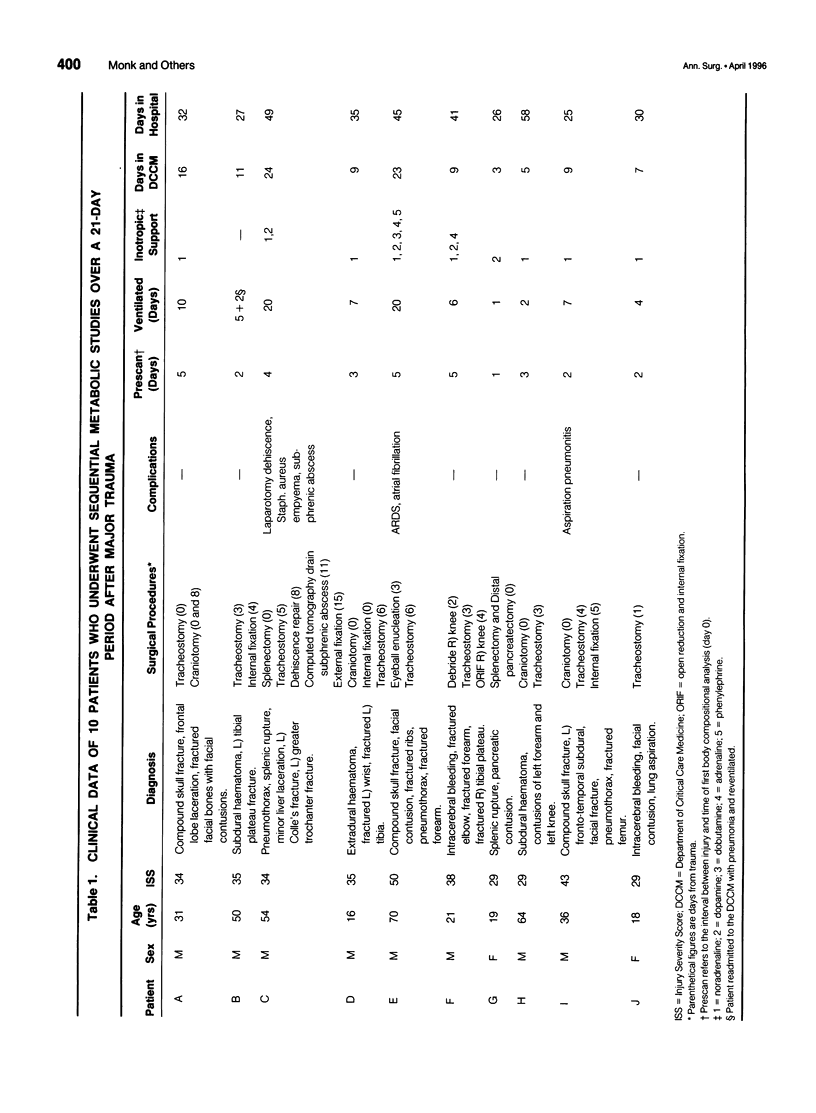
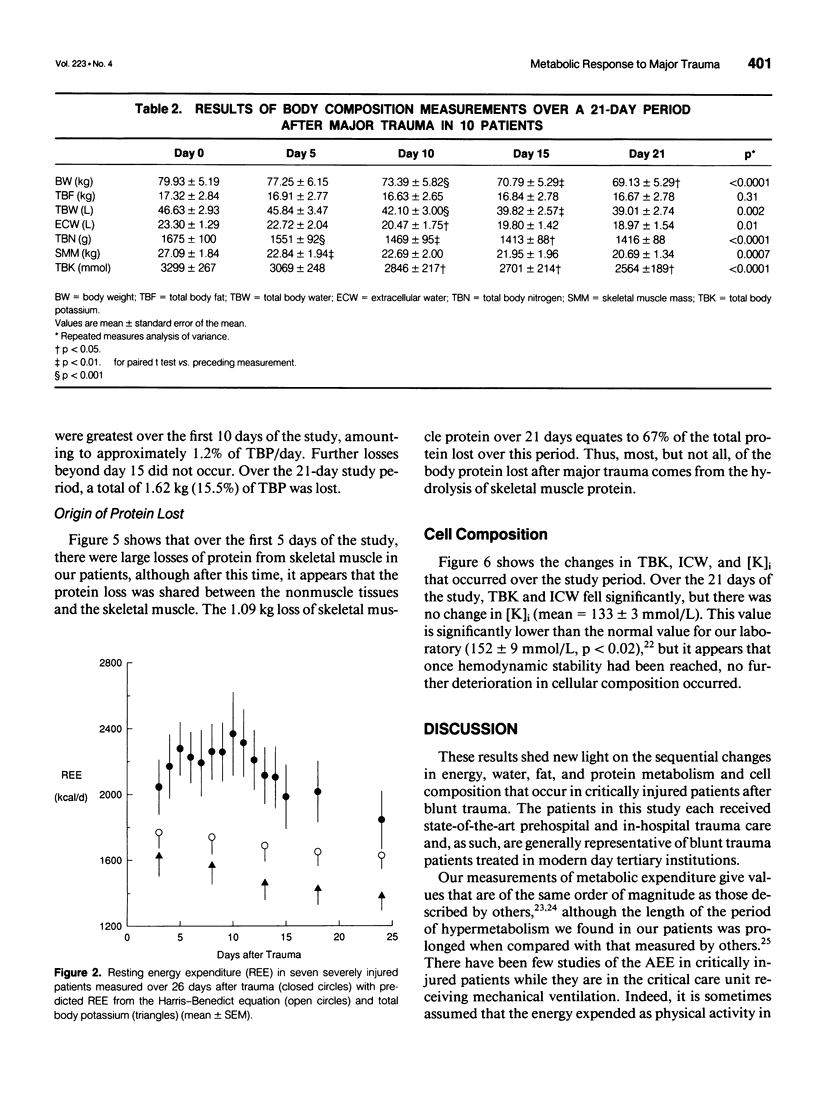
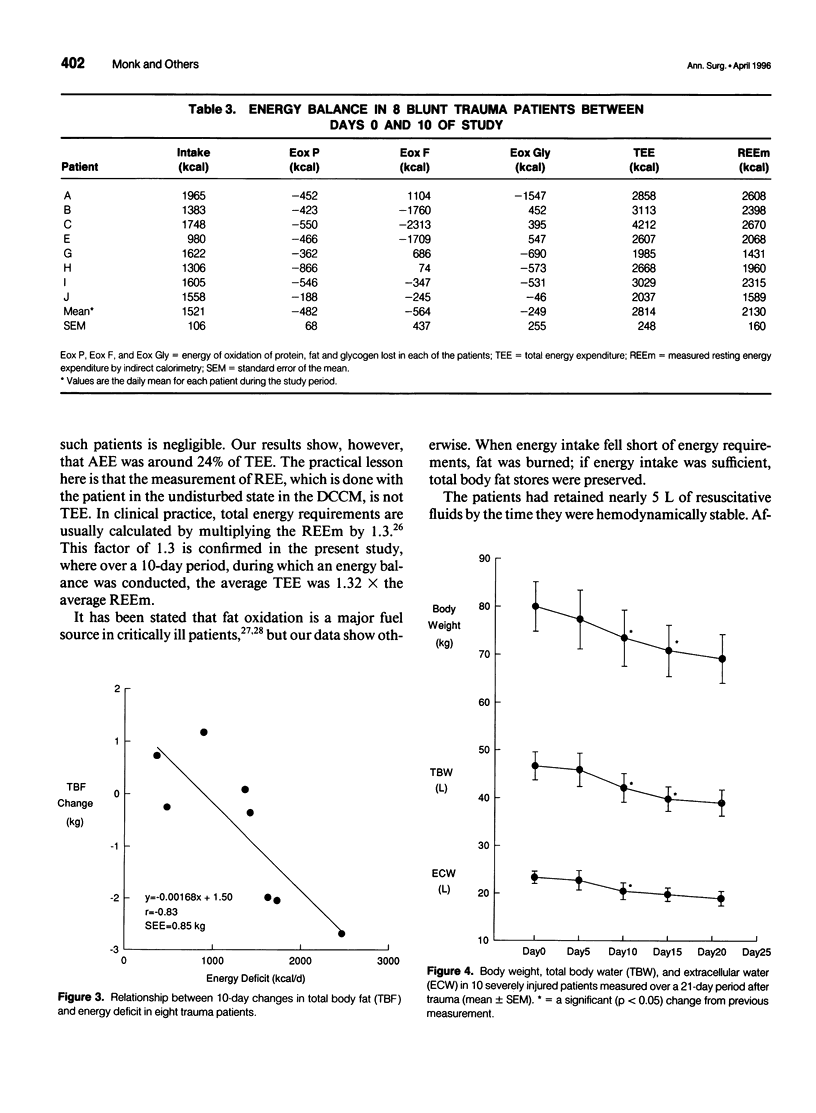
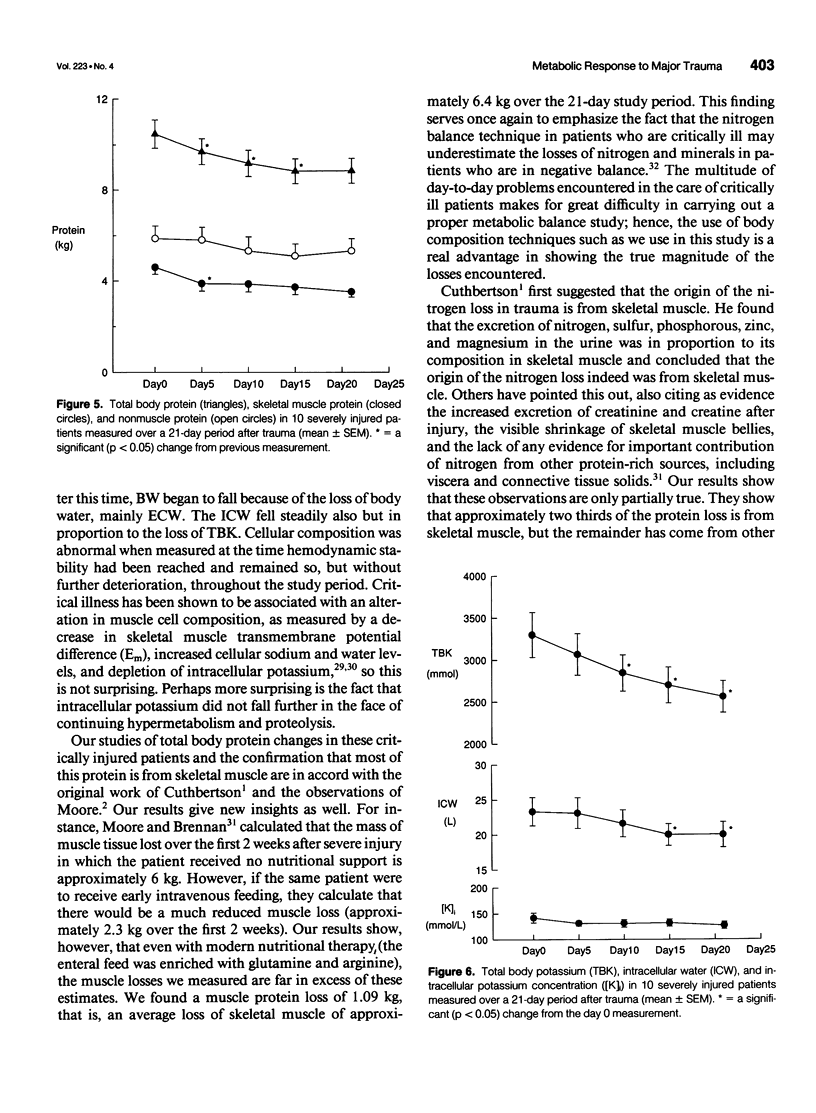
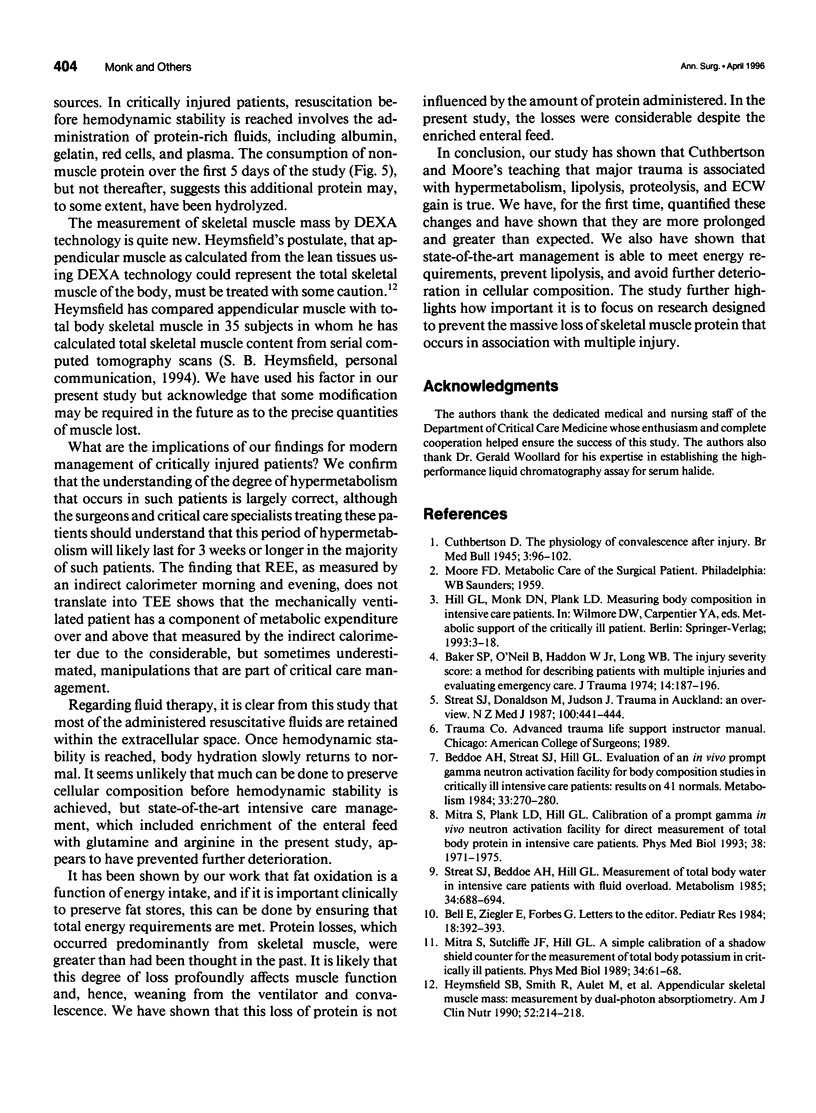
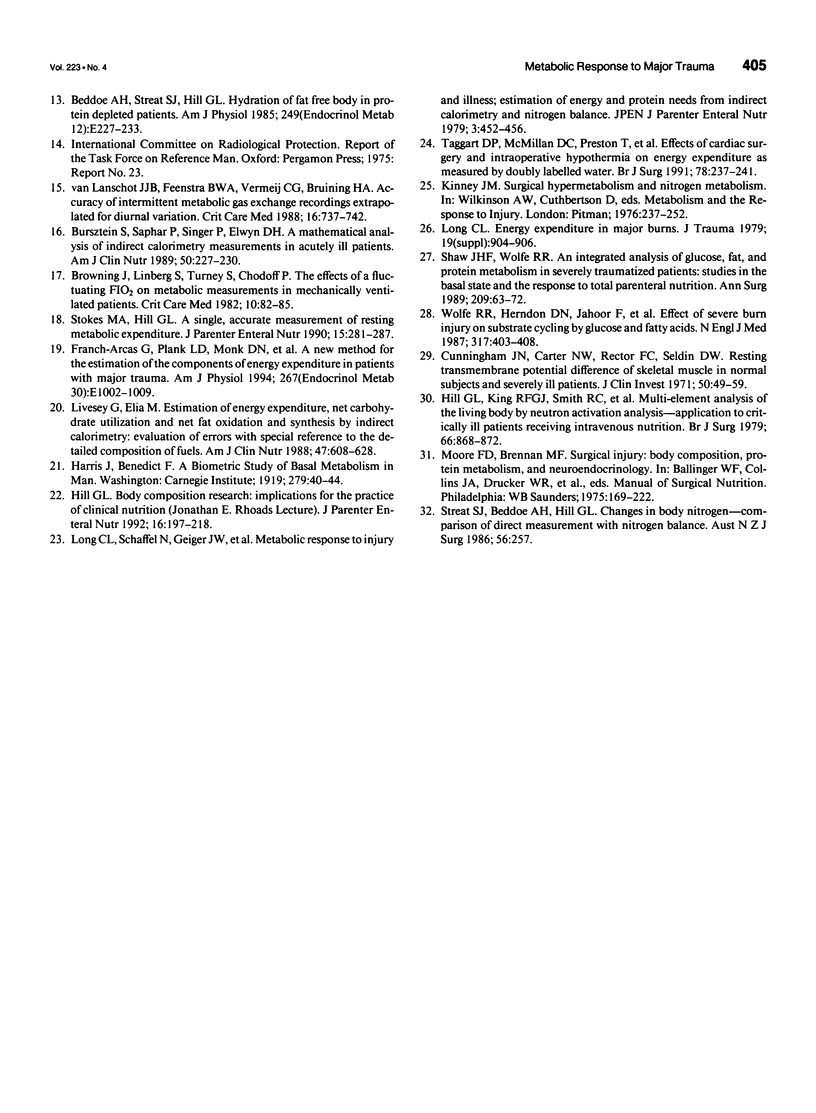
Images in this article
Selected References
These references are in PubMed. This may not be the complete list of references from this article.
- Baker S. P., O'Neill B., Haddon W., Jr, Long W. B. The injury severity score: a method for describing patients with multiple injuries and evaluating emergency care. J Trauma. 1974 Mar;14(3):187–196. [PubMed] [Google Scholar]
- Beddoe A. H., Streat S. J., Hill G. L. Evaluation of an in vivo prompt gamma neutron activation facility for body composition studies in critically ill intensive care patients: results on 41 normals. Metabolism. 1984 Mar;33(3):270–280. doi: 10.1016/0026-0495(84)90050-7. [DOI] [PubMed] [Google Scholar]
- Beddoe A. H., Streat S. J., Hill G. L. Hydration of fat-free body in protein-depleted patients. Am J Physiol. 1985 Aug;249(2 Pt 1):E227–E233. doi: 10.1152/ajpendo.1985.249.2.E227. [DOI] [PubMed] [Google Scholar]
- Bell E. F., Ziegler E. E., Forbes G. B. Corrected bromide space. Pediatr Res. 1984 Apr;18(4):392–393. doi: 10.1203/00006450-198404000-00021. [DOI] [PubMed] [Google Scholar]
- Browning J. A., Linberg S. E., Turney S. Z., Chodoff P. The effects of a fluctuating Fio2 on metabolic measurements in mechanically ventilated patients. Crit Care Med. 1982 Feb;10(2):82–85. doi: 10.1097/00003246-198202000-00003. [DOI] [PubMed] [Google Scholar]
- Bursztein S., Saphar P., Singer P., Elwyn D. H. A mathematical analysis of indirect calorimetry measurements in acutely ill patients. Am J Clin Nutr. 1989 Aug;50(2):227–230. doi: 10.1093/ajcn/50.2.227. [DOI] [PubMed] [Google Scholar]
- Cunningham J. N., Jr, Carter N. W., Rector F. C., Jr, Seldin D. W. Resting transmembrane potential difference of skeletal muscle in normal subjects and severely ill patients. J Clin Invest. 1971 Jan;50(1):49–59. doi: 10.1172/JCI106483. [DOI] [PMC free article] [PubMed] [Google Scholar]
- Franch-Arcas G., Plank L. D., Monk D. N., Gupta R., Maher K., Gillanders L., Hill G. L. A new method for the estimation of the components of energy expenditure in patients with major trauma. Am J Physiol. 1994 Dec;267(6 Pt 1):E1002–E1009. doi: 10.1152/ajpendo.1994.267.6.E1002. [DOI] [PubMed] [Google Scholar]
- Heymsfield S. B., Smith R., Aulet M., Bensen B., Lichtman S., Wang J., Pierson R. N., Jr Appendicular skeletal muscle mass: measurement by dual-photon absorptiometry. Am J Clin Nutr. 1990 Aug;52(2):214–218. doi: 10.1093/ajcn/52.2.214. [DOI] [PubMed] [Google Scholar]
- Hill G. L. Jonathan E. Rhoads Lecture. Body composition research: implications for the practice of clinical nutrition. JPEN J Parenter Enteral Nutr. 1992 May-Jun;16(3):197–218. doi: 10.1177/0148607192016003197. [DOI] [PubMed] [Google Scholar]
- Hill G. L., King R. F., Smith R. C., Smith A. H., Oxby C. B., Sharafi A., Burkinshaw L. Multi-element analysis of the living body by neutron activation analysis-application to critically ill patients receiving intravenous nutrition. Br J Surg. 1979 Dec;66(12):868–872. doi: 10.1002/bjs.1800661210. [DOI] [PubMed] [Google Scholar]
- Livesey G., Elia M. Estimation of energy expenditure, net carbohydrate utilization, and net fat oxidation and synthesis by indirect calorimetry: evaluation of errors with special reference to the detailed composition of fuels. Am J Clin Nutr. 1988 Apr;47(4):608–628. doi: 10.1093/ajcn/47.4.608. [DOI] [PubMed] [Google Scholar]
- Long C. L., Schaffel N., Geiger J. W., Schiller W. R., Blakemore W. S. Metabolic response to injury and illness: estimation of energy and protein needs from indirect calorimetry and nitrogen balance. JPEN J Parenter Enteral Nutr. 1979 Nov-Dec;3(6):452–456. doi: 10.1177/014860717900300609. [DOI] [PubMed] [Google Scholar]
- Long C. Energy expenditure of major burns. J Trauma. 1979 Nov;19(11 Suppl):904–906. [PubMed] [Google Scholar]
- Mitra S., Plank L. D., Hill G. L. Calibration of a prompt gamma in vivo neutron activation facility for direct measurement of total body protein in intensive care patients. Phys Med Biol. 1993 Dec;38(12):1971–1975. doi: 10.1088/0031-9155/38/12/019. [DOI] [PubMed] [Google Scholar]
- Mitra S., Sutcliffe J. F., Hill G. L. A simple calibration of a shadow shield counter for the measurement of total body potassium in critically ill patients. Phys Med Biol. 1989 Jan;34(1):61–68. doi: 10.1088/0031-9155/34/1/006. [DOI] [PubMed] [Google Scholar]
- Shaw J. H., Wolfe R. R. An integrated analysis of glucose, fat, and protein metabolism in severely traumatized patients. Studies in the basal state and the response to total parenteral nutrition. Ann Surg. 1989 Jan;209(1):63–72. doi: 10.1097/00000658-198901000-00010. [DOI] [PMC free article] [PubMed] [Google Scholar]
- Stokes M. A., Hill G. L. A single, accurate measurement of resting metabolic expenditure. JPEN J Parenter Enteral Nutr. 1991 May-Jun;15(3):281–287. doi: 10.1177/0148607191015003281. [DOI] [PubMed] [Google Scholar]
- Streat S. J., Beddoe A. H., Hill G. L. Measurement of total body water in intensive care patients with fluid overload. Metabolism. 1985 Jul;34(7):688–694. doi: 10.1016/0026-0495(85)90099-x. [DOI] [PubMed] [Google Scholar]
- Streat S. J., Donaldson M. L., Judson J. A. Trauma in Auckland: an overview. N Z Med J. 1987 Jul 22;100(828):441–444. [PubMed] [Google Scholar]
- Taggart D. P., McMillan D. C., Preston T., Richardson R., Burns H. J., Wheatley D. J. Effects of cardiac surgery and intraoperative hypothermia on energy expenditure as measured by doubly labelled water. Br J Surg. 1991 Feb;78(2):237–241. doi: 10.1002/bjs.1800780236. [DOI] [PubMed] [Google Scholar]
- Wolfe R. R., Herndon D. N., Jahoor F., Miyoshi H., Wolfe M. Effect of severe burn injury on substrate cycling by glucose and fatty acids. N Engl J Med. 1987 Aug 13;317(7):403–408. doi: 10.1056/NEJM198708133170702. [DOI] [PubMed] [Google Scholar]
- van Lanschot J. J., Feenstra B. W., Vermeij C. G., Bruining H. A. Accuracy of intermittent metabolic gas exchange recordings extrapolated for diurnal variation. Crit Care Med. 1988 Aug;16(8):737–742. doi: 10.1097/00003246-198808000-00001. [DOI] [PubMed] [Google Scholar]



